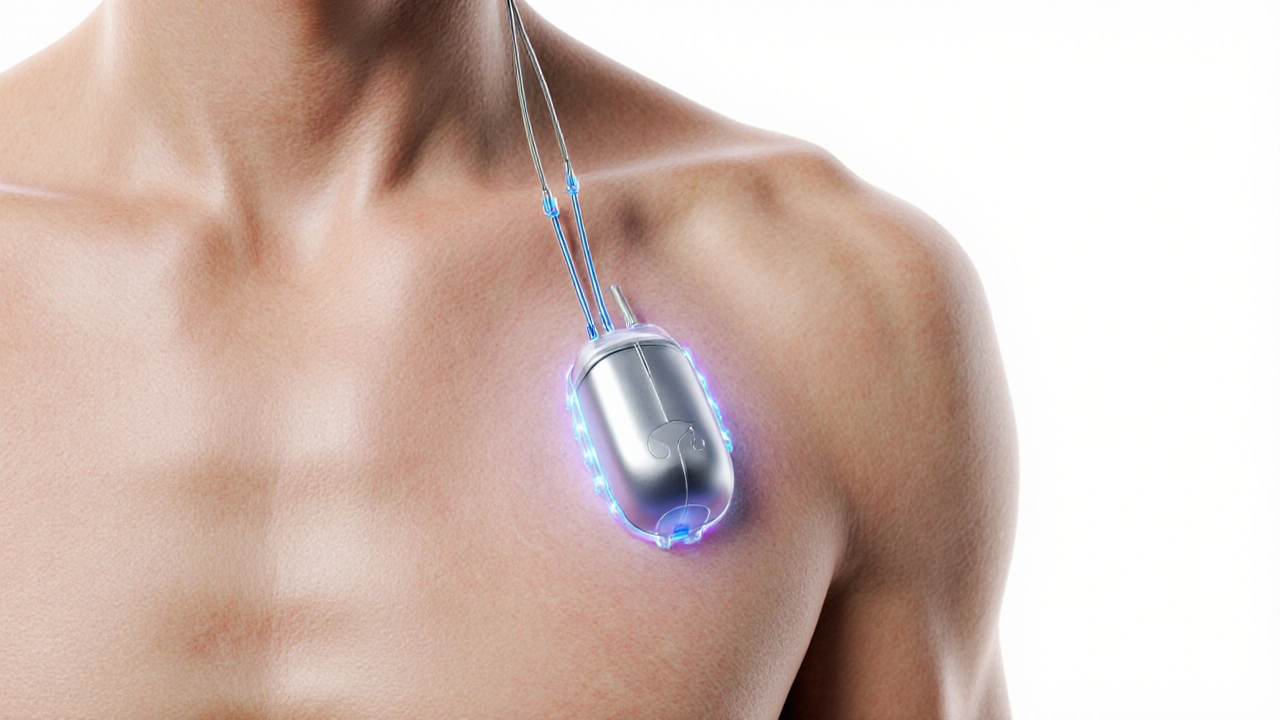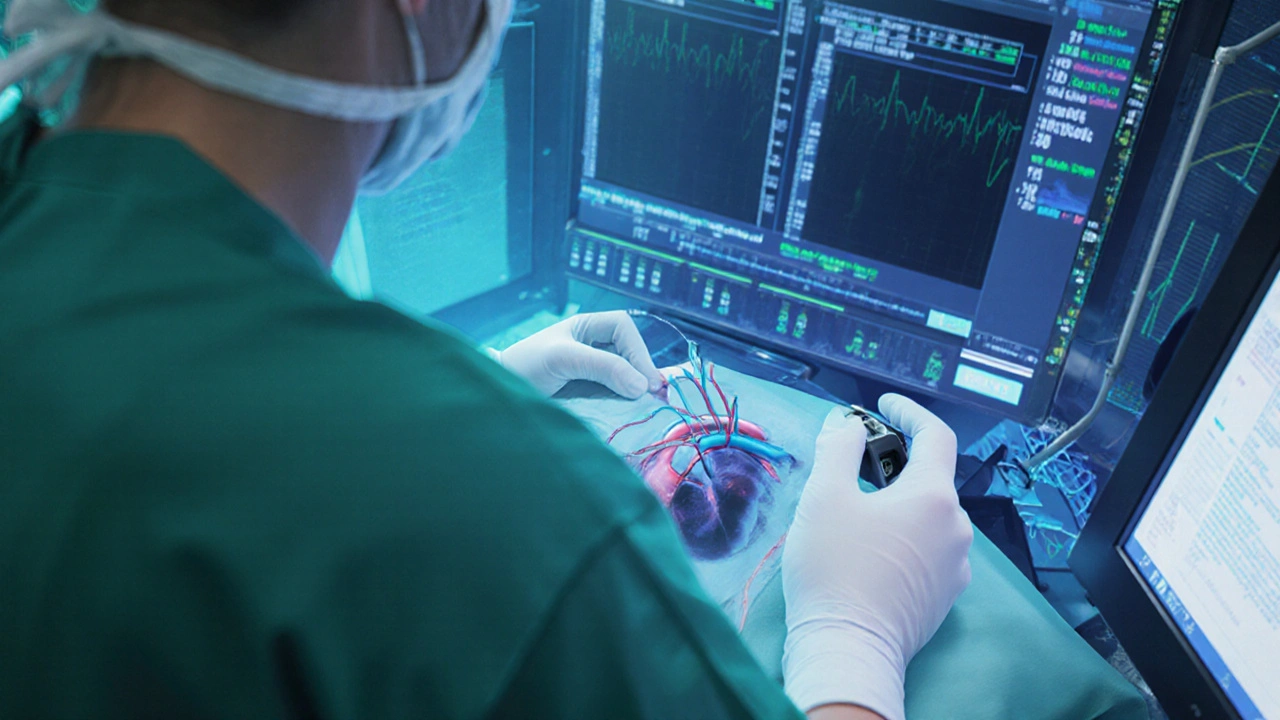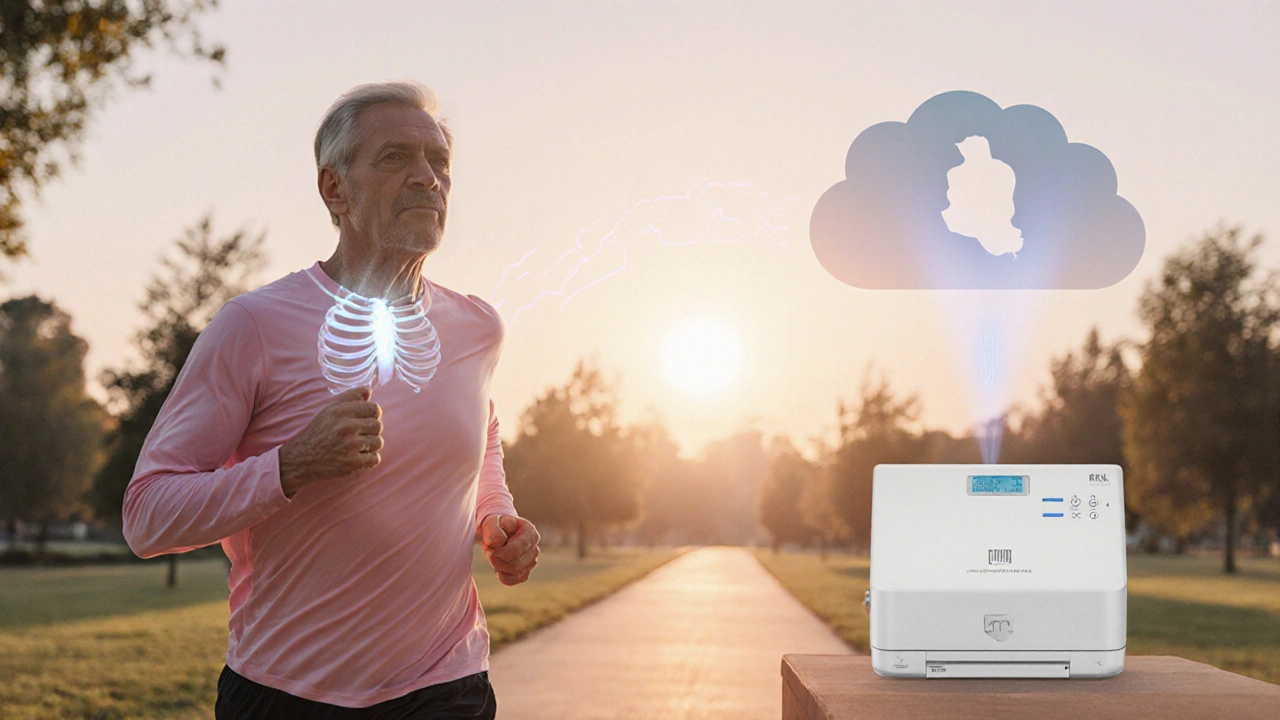 Oct, 6 2025
Oct, 6 2025
Pacemaker Condition Checker
This tool helps determine if a pacemaker might be recommended based on common heart rhythm conditions. It's intended for educational purposes and should not replace professional medical advice.
Bradycardia
Heart rate below 60 beats per minute at rest, causing fatigue or dizziness.
Heart Block
Electrical signals between heart chambers are blocked or delayed.
Atrial Fibrillation
Irregular heartbeat with slow ventricular response.
Other Arrhythmias
Other types of irregular heartbeats that may require pacing.
Recommendation:
When your heart skips a beat or races without warning, it feels like your body is out of sync. pacemakers are the tiny devices that bring order back, giving millions of people a steady rhythm and a normal life. Below you’ll learn exactly what a pacemaker does, when it’s needed, and how it fits into modern heart‑care.
Key Takeaways
- A pacemaker is an implanted device that monitors and corrects slow or irregular heart rhythms.
- It’s most often used for bradycardia, heart block, and certain types of atrial fibrillation.
- The system consists of a generator (the "brain") and leads (the "wires").
- Implantation is done by a cardiologist or cardiac electrophysiologist after thorough testing.
- Modern pacemakers offer remote monitoring, MRI‑compatibility, and long‑lasting batteries.
What Is a Pacemaker?
Pacemaker is a small, battery‑powered device implanted under the skin near the collarbone. It continuously monitors the heart’s electrical activity and delivers tiny electrical pulses when the rhythm slows down or pauses, ensuring the heart beats at an appropriate rate. The first commercial pacemaker appeared in the 1960s, and today’s models are programmable, MRI‑safe, and often equipped with wireless telemetry.
How Pacemakers Treat Different Types of Irregular Heartbeat
Not all arrhythmias are the same, and a pacemaker isn’t a one‑size‑fits‑all solution. Understanding the specific condition helps explain why the device is chosen.
Bradycardia is a condition where the heart beats fewer than 60 times per minute at rest. It can cause fatigue, dizziness, or fainting. A pacemaker detects the slow rate and emits a pulse to bring the heart back up to a preset minimum, typically 60-70 beats per minute.
Heart block occurs when the electrical signal from the atria fails to reach the ventricles. In second‑degree or third‑degree (complete) block, the ventricles may beat independently and far too slowly. The pacemaker acts as a bridge, delivering impulses directly to the ventricles at a reliable pace.
Atrial fibrillation is an irregular, often rapid rhythm originating in the atria. While many patients receive anticoagulants, those with a slow ventricular response (known as "ventricular rate control") may benefit from a pacemaker that ensures a steady ventricular rate.
Other arrhythmias, such as certain types of tachycardia, are better treated with an implantable cardioverter‑defibrillator (ICD) rather than a standard pacemaker.

Components of a Pacemaker System
The system has two main parts:
- Generator (the "brain") houses the battery, electronic circuitry, and programmable software. Modern generators can last 8-12 years before replacement is needed.
- Leads (the "wires") are thin insulated cables that connect the generator to the heart tissue. Leads can be placed in the right atrium, right ventricle, or both, depending on the pacing mode required.
Leads are either passive‑fixation (tines that lodge in the heart wall) or active‑fixation (a tiny screw that drills into the tissue). The choice depends on patient anatomy and physician preference.
Patient Evaluation and Implant Procedure
Before a device is implanted, a thorough assessment is performed. The first step is usually an electrophysiology study (EPS), where catheters record the heart’s electrical signals and test how it responds to programmed stimuli. The EPS helps confirm the diagnosis and determines the optimal pacing mode.
The actual implantation is a minimally invasive procedure performed in a cardiac catheterization lab or operating room. A cardiologist or cardiac electrophysiologist makes a small incision below the clavicle, creates a pocket for the generator, and threads the leads through a vein into the heart. Fluoroscopy (real‑time X‑ray) guides placement, and the device is programmed before the incision is closed.
Patients typically stay overnight for observation, and most can return to normal activities within a week, avoiding heavy lifting for about six weeks.
Choosing Between a Pacemaker and an ICD
When a patient has both slow and fast dangerous rhythms, doctors may consider an implantable cardioverter‑defibrillator (ICD). An ICD can pace like a regular pacemaker but also delivers a high‑energy shock to stop life‑threatening tachyarrhythmias. Below is a quick side‑by‑side comparison.
| Feature | Pacemaker | ICD |
|---|---|---|
| Primary purpose | Correct bradycardia / heart block | Prevent sudden cardiac death from ventricular tachycardia/fibrillation |
| Shock capability | No | Yes (up to 40J) |
| Battery life | 8‑12years | 5‑7years (higher energy use) |
| Size | Smaller, lighter | Slightly larger due to capacitor |
| Typical candidates | Bradyarrhythmia, heart block | History of ventricular tachycardia, low ejection fraction |
Choosing the right device hinges on the specific rhythm disorder, overall cardiac function, and patient lifestyle.

Lifestyle Considerations & Ongoing Follow‑up
Modern devices come with features that make daily life easier. Remote monitoring lets the pacemaker transmit data to a secure web portal via a bedside transmitter. Physicians receive alerts if the battery drops, lead impedance changes, or abnormal rhythms are detected. This reduces clinic visits and catches problems early.
Many patients worry about MRI scans. Today’s MRI‑compatible pacemakers are labeled “MR‑Conditional,” meaning a scan can be performed safely under specific settings (e.g., 1.5T field, limited scan area). Always inform the radiology team about the device model.
Activity restrictions are minimal. You can jog, swim, and exercise, but avoid strong electromagnetic fields-like those from industrial welding equipment-unless cleared by your doctor. Also, keep a magnetic card handy; it can temporarily suspend pacing if a strong magnet is placed over the generator (useful in rare emergencies).
Risks, Common Myths, and Troubleshooting
Implantation carries typical surgical risks: infection, bleeding, or lead displacement (occurs in ~1‑2% of cases). Most issues are solved with a simple outpatient procedure.
Common myths:
- Myth: A pacemaker will “speed up” an already fast heart. Fact: Pacemakers are programmed to intervene only when the heart falls below a set threshold.
- Myth: You can’t use electronic devices near a pacemaker. Fact: Everyday items-cell phones, microwaves, laptops-are safe at a normal distance (at least 6 inches).
- Myth: The device will stop working after a few years. Fact: Batteries are designed for up to 12 years; replacement surgery is straightforward.
If you notice dizziness, fainting, or a buzzing sensation near the device, contact your cardiology clinic promptly. Simple re‑programming often resolves these symptoms.
Frequently Asked Questions
How long does a pacemaker battery last?
Most modern generators hold a charge for 8-12 years, depending on pacing needs and device settings. When the battery reaches its end‑of‑life, the device alerts the physician, and a replacement procedure is scheduled.
Can I get an MRI with a pacemaker?
Only if the pacemaker is labeled MR‑Conditional. The scan must follow the manufacturer’s specific protocols (field strength, scan duration, and positioning). Always verify with both your cardiologist and the radiology team before scheduling.
Will a pacemaker affect my job or travel?
In most cases, no. You can work, travel, and fly without restrictions. The only caution is to keep your device ID card handy and notify security personnel if asked about metal implants. For jobs involving strong electromagnetic fields, obtain clearance from your physician.
How often do I need follow‑up appointments?
Initial check‑ups occur at 1 month, 6 months, and 12 months post‑implant. After that, yearly visits are typical unless remote monitoring flags an issue. Your doctor will tailor the schedule to your health status.
Can a pacemaker be upgraded to an ICD?
Sometimes, especially if the patient later develops ventricular tachyarrhythmias. The procedure usually involves adding a new lead and replacing the generator with an ICD unit; the existing pocket can be reused, minimizing additional surgery.
Geneva Lyra
October 6, 2025 AT 14:07Thanks for putting together such a clear guide! I really appreciate the effort you put into breaking down the different arrhythmias and how pacemakers help. It's super helpful for folks who might be feeling overwhelmed by the medical jargon. Also, kudos for including the interactive checklist – that makes the info way more accessible. Keep sharing knowledge like this, it truly makes a difference. :)
Moritz Bender
October 7, 2025 AT 04:00Great overview! The article does a solid job elucidating the electrophysiological basis of bradycardia and AV block, as well as the algorithmic pacing modes like DDD and VVI. I especially liked the section on MRI‑conditional generators – that's a crucial nuance for patients undergoing imaging. The inclusion of remote telemetry protocols also underscores the shift toward tele‑cardiology. Overall, a thorough and technically sound piece. :)
Nicole Hernandez
October 7, 2025 AT 17:54This guide is impressively comprehensive, covering everything from the basics of pacemaker anatomy to the subtleties of lead fixation techniques. It begins by defining the physiological need for pacing in cases of bradycardia, which sets a clear foundation for readers. The explanation of heart block is both accurate and accessible, noting the difference between second‑degree type I and type II block. Further, the discussion of atrial fibrillation with a slow ventricular response highlights a scenario often overlooked in general health articles. The breakdown of device components-generator and leads-clarifies the modular nature of the system, which is essential for patients considering future upgrades. I also appreciate the step‑by‑step description of the implantation procedure, including the use of fluoroscopic guidance. The inclusion of post‑procedure care, such as activity restrictions and the typical timeline for follow‑up visits, provides practical guidance. Moreover, the comparison between pacemakers and ICDs helps readers discern when each device is appropriate. The section on MRI‑compatible models addresses a common patient concern with up‑to‑date information. Lifestyle considerations, like remote monitoring and magnetic interference precautions, are presented in a user‑friendly manner. The myth‑busting list effectively dispels common misconceptions, which can otherwise cause unnecessary anxiety. By outlining potential complications and their typical management, the article prepares patients for realistic expectations. The FAQ segment neatly consolidates key queries about battery longevity, MRI safety, employment implications, and follow‑up schedules. Finally, the tone remains supportive throughout, encouraging patients to engage with their cardiology team. In sum, this article serves as an excellent educational resource for both patients and caregivers alike.
florence tobiag
October 8, 2025 AT 07:47Wow... another piece glorifying a device that the big med‑industry pushes on the unsuspecting masses!!! Have you even considered that these "pacemakers" might be part of a larger agenda to make us dependent on implanted tech?; The fact that the article glosses over the long‑term risks and just focuses on convenience is downright alarming; Do they ever mention the hidden data collection potential?!! It’s as if they want us to accept it without questioning the ethical implications!!!
Terry Washington
October 8, 2025 AT 21:40Let me set the record straight: the sensationalist tone here is misleading and reeks of fear‑mongering. Pacemakers are rigorously tested, FDA‑approved devices with decades of proven safety. The article’s insinuations about covert agendas are baseless and divert attention from the real benefits-restoring quality of life for patients with life‑threatening bradyarrhythmias. Instead of peddling paranoia, we should celebrate biomedical progress.
Claire Smith
October 9, 2025 AT 11:34The guide is well‑structured, though it could benefit from a more concise summary of the key takeaways for quick reference.
Émilie Maurice
October 10, 2025 AT 01:27This article is overly dense and fails to highlight the serious infection risks associated with implanting foreign objects. Simpler language would help readers grasp the dangers.
Ellie Haynal
October 10, 2025 AT 15:20I’ve seen too many patients hesitate because they’re scared of the unknown, and this piece does a wonderful job of easing that fear. The emotional weight of living with an irregular heartbeat is palpable, and presenting the pacemaker as a beacon of stability is both hopeful and empowering. It really resonates with anyone who’s felt the panic of a missed beat.
Jimmy Gammell
October 11, 2025 AT 05:14Really solid info here! If anyone’s feeling unsure, just remember you’re not alone – doctors and support groups have your back. Keep the positive vibes going! :)
fred warner
October 11, 2025 AT 19:07Excellent write‑up! The clarity and optimism will surely motivate patients to take charge of their heart health. Well done!
Veronica Mayfair
October 12, 2025 AT 09:00👍 Super helpful! 🌟